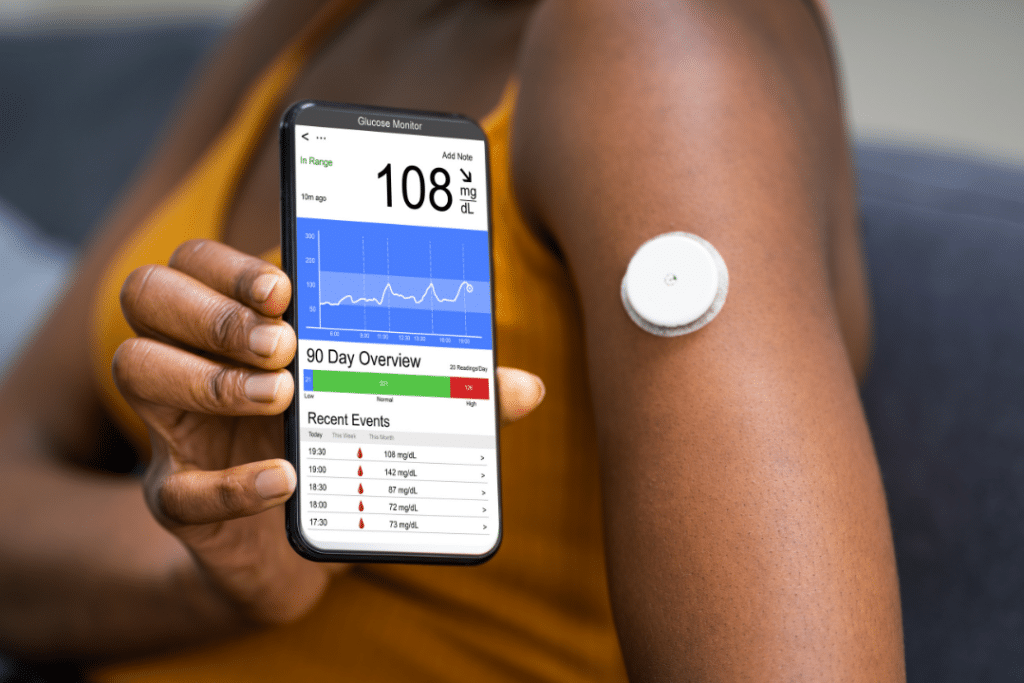|
Getting your Trinity Audio player ready...
|
Takeaways
- Diabetes is a metabolic disorder that occurs when your body has chronic, high levels of blood sugar.
- Type 2 diabetes accounts for 90-95% of diabetes diagnoses, and it is preventable and manageable.
- Eating healthy and exercising can help manage your diabetes.
Table of Contents
Diet for Managing Type 2 Diabetes
Exercise for Managing Type 2 Diabetes
Diabetes: An Overview
A diagnosis of diabetes completely changes how you live your life.
You start putting a magnifying glass to nutrition facts. You constantly take blood sugar tests. You worry all the time.
But that does not have to be the case. You can live a full life with diabetes, but changes are needed.
Diabetes is a chronic disease that affects your metabolism. According to the Mayo Clinic diabetes can lead to:
- Heart disease
- Nerve Damage
- Kidney Disease
- Visual Changes and Eye Damage
- Poor Wound Healing
- Sleep Apnea
- Dementia (like Alzheimer’s disease)
Diabetes occurs when blood sugar levels are chronically high. Chronically high blood sugar occurs when your body either:
- Cannot produce enough insulin
- Cannot effectively use insulin
Insulin is a naturally occurring hormone that helps you manage your blood sugar levels.
Specifically, insulin works to increase the amount of blood sugar absorbed by your liver, fat, or muscle cells.
In 2021, over 500 million people worldwide were reported to live with diabetes. Because of this, diabetes treatment and management resulted in a worldwide cost of nearly 1 trillion dollars.
This study, funded by the Bill & Melinda Gates Foundation, estimates that over 1 billion people will have diabetes by 2050.
Further, in the United States alone, 96 million adults have prediabetes, according to the CDC.
That is more than 1 of every 3 people have prediabetes, and 80% of them don’t know they have it. Up to 70% of people with prediabetes are predicted to develop type 2 diabetes, according to one report.
It is important to understand diabetes and how it affects your life. Whenever you hear about diabetes, you might not realize that there are multiple types. The CDC states that these include:
- Type 1 Diabetes – occurs when insulin is not produced by your body
- Type 2 Diabetes – occurs when your body becomes resistant to insulin
- Gestational Diabetes – occurs if insulin production is too low during pregnancy
Each of these cause unique changes to your body. Being aware of how each affects you will help you understand why certain lifestyle changes are needed.
Because there is so much to each type of diabetes, this blog will focus on type 2 diabetes.
Type 2 diabetes is known to account for 90-95% of all diabetes diagnoses.
And type 2 diabetes is preventable. An expert in type 2 diabetes management, Beverly Yates, ND, believes that you can even reverse it.
Keep reading to learn about the causes of type 2 diabetes and what you can do to manage it in collaboration with your doctor.

What Causes Type 2 Diabetes?
There are several factors that increase your risk of developing type 2 diabetes. There are genetic factors reported to increase the chance of type 2 diabetes. However, it appears that lifestyle factors are the primary cause of type 2 diabetes.
1) Poor Diet
A diet high in sugars, red meats, and fried foods greatly increases the risk of developing type 2 diabetes, according to a key report. It is also possible that food sensitivities or intolerances may also cause you to have spikes in blood glucose.
“If you’re eating healthy foods that are full of food sensitivity reactions, food intolerances for you, that could spike your blood sugar, that could also lead to increasing inflammation if you’re having an adverse reaction to particular food, even though it’s healthy,” states Dr. Beverly Yates in an interview.
2) Chronic Stress
It is well known that hormones released from stress are linked with increases in blood sugar. One clinical review discusses that stress hormones like glucocorticoids and catecholamines can disrupt glucose homeostasis. This leads to the breakdown of glycogen and the release of glucose into the blood. That review also states that chronic exposure to catecholamines, like epinephrine and norepinephrine, prevents sugar from being taken up by cells, which leads to chronically high blood sugar and even insulin resistance.
3) Little to No Physical Activity
Low physical activity is reported to increase the risk of developing diabetes by 30%. Exercise helps your body use insulin better and also controls blood glucose.
4) Poor Sleep
One key review reported that 7-8 hours of sleep each night was associated with the lowest risk of developing type 2 diabetes. That review reported that your risk increases by 9% for each hour less of sleep.
5) Smoking
An essential review reported that light smoking increases your risk of getting type 2 diabetes by 30%. Heavy smoking increases that risk by 60%.
Overall, there are many lifestyle factors that you can take control of to prevent or manage type 2 diabetes.

- Access the Reversing Type II Diabetes Summit
Learn from top leaders in the field the skills you need today.
Type 2 Diabetes Medications
Type 2 diabetes does not mean that you must completely change your life. Type 2 diabetes can be managed well with the right steps.
There are medications available to assist you in managing type 2 diabetes. The Mayo Clinic reports that some key medications used are:
- Meglitinides or Sulfonylureas – these help your pancreas release insulin
- Dipeptidyl-peptidase 4 inhibitors – these assist in the release of insulin when blood sugar rises while also limiting the sugar release from the liver
- Biguanides (commonly known as Metformin) – these limit sugar release from the liver while also improving your insulin sensitivity
- Sodium-glucose transporter 2 inhibitors – decreases your kidney’s ability to take sugar from urine
- Amylin mimetics – these are used with insulin to help regulate blood glucose and also slow food movement in the body
- Incretin mimetics – these help your body release insulin as blood glucose rises
These options are provided purely for informative purposes. Please consult your doctor about any medications related to managing type 2 diabetes.
Diet for Managing Type 2 Diabetes
The key to managing type 2 diabetes lies in how you eat. You should consider what foods you should eat and what you should avoid.
In general, you want to ensure that you eat healthy carbohydrates, healthy proteins, lots of fiber, and what are known as “good” fats.
Foods that are high in healthy carbohydrates and fiber are:
- Fruits and vegetables
- Legumes
- Whole Grains
Foods that are high in good fats are:
- Olive oils
- Nuts
- Avocados
- Fish like salmon, mackerel, and sardines

The Mayo Clinic recommends that you should limit foods that are high in:
- Simple sugars – white sugars, drinks with high fructose corn syrup, and sweetened food products
- Saturated Fats – bacon, sausage, hot dogs, high-fat dairy products, and palm kernel oils
- Trans Fats – Shortenings and margarines
- Salt – it is recommended to consume less than 2,300mg per day so be sure to check nutritional facts
Another consideration is your source of caffeine. One report found that flavanol-rich green tea improved control of blood sugar levels.
Again, always consult your doctor before making significant lifestyle changes.
Exercise for Managing Type 2 Diabetes
Exercise is another key factor for managing diabetes. Harvard reported that regular exercise will:
- Help manage your weight
- Improve your blood pressure
- Improve your cholesterol
- Lower blood glucose levels
- Improve insulin resistance
The Mayo Clinic recommends that you should aim to get:
- At least 2.5 hours of fast walking, swimming, running, or bicycling per week
- Weight lifting, yoga, or calisthenics 2-3 times per week
- Limiting how long you are inactive – every 30 minutes, stand and do a form of light activity like walking
Getting into a routine is especially important. Trying to do it all at once is difficult. As Dr. Beverly Yates likes to say, “It’s all about progress, not perfection.”
Summary
Type 2 diabetes requires you to make some changes in your life, but these changes are simple. Taking one step at a time is the key to getting your diabetes under control. Being sure to eat a healthy diet, exercise, eliminate smoking, limit alcohol intake, and getting good sleep are essential.
References
- Mayo Clinic Staff. (2023). Type 2 Diabetes. Mayo Clinic. Read it here.
- GBD 2021 Diabetes Collaborators. (2023). Global, regional, and national burden of diabetes from 1990 to 2021, with projections of prevalence to 2050: a systematic analysis for the Global Burden of Disease Study 2021. Lancet; 402(10397):203-234. Read it here.
- Center for Disease Control and Prevention. (2023). What is Diabetes? CDC. Read it here.
- Tabák, A. G., Herder, C., Rathmann, W., Brunner, E. J., & Kivimäki, M. (2012). Prediabetes: a high-risk state for diabetes development. Lancet (London, England), 379(9833), 2279–2290. Read it here.
- Wu, Y., Ding, Y., Tanaka, Y., & Zhang, W. (2014). Risk factors contributing to type 2 diabetes and recent advances in the treatment and prevention. International journal of medical sciences, 11(11), 1185–1200. Read it here.
- Panagiotakos, D. B., Tzima, N., Pitsavos, C., Chrysohoou, C., Papakonstantinou, E., Zampelas, A., & Stefanadis, C. (2005). The relationship between dietary habits, blood glucose and insulin levels among people without cardiovascular disease and type 2 diabetes; the ATTICA study. The review of diabetic studies : RDS, 2(4), 208–215. Read it here.
- Kolb, H., & Martin, S. (2017). Environmental/lifestyle factors in the pathogenesis and prevention of type 2 diabetes. BMC medicine, 15(1), 131. Read it here.
- Shan, Z., Ma, H., Xie, M., Yan, P., Guo, Y., Bao, W., Rong, Y., Jackson, C. L., Hu, F. B., & Liu, L. (2015). Sleep duration and risk of type 2 diabetes: a meta-analysis of prospective studies. Diabetes care, 38(3), 529–537. Read it here.
- Mayo Clinic Staff. (2022). Diabetes treatment: Medications for type 2 diabetes. Mayo Clinic. Read it here.
- Mayo Clinic Staff. (2023). Diabetes diet: Create your healthy-eating plan. Mayo Clinic. Read it here.
- Zheng, X. X., Xu, Y. L., Li, S. H., Hui, R., Wu, Y. J., & Huang, X. H. (2013). Effects of green tea catechins with or without caffeine on glycemic control in adults: a meta-analysis of randomized controlled trials. The American journal of clinical nutrition, 97(4), 750–762. Read it here.
- Harvard Health Publishing. (2023). The importance of exercise when you have diabetes. Harvard Medical School. Read it here.
- Mayo Clinic Staff. (2023). Diabetes prevention: 5 tips for taking control. Mayo Clinic. Read it here.



My family has a history of type II Diabetes, and this blog post really hits home. It’s a stark reminder that diabetes isn’t just about the physical aspects, but also about the constant vigilance and lifestyle changes needed. The detailed breakdown of causes and the emphasis on manageable changes give hope. It’s encouraging to see that with the right diet, exercise, and sleep patterns, there’s a way to keep diabetes in check. Also, the mention of new treatments and the Yates Protocol offers some optimism. It’s all about taking those small, steady steps towards a healthier life.